#Sakyamuni Buddha
Explore tagged Tumblr posts
Text
Himalayan Nyingmapa Gompa, Manali | A Spiritual Gem in Himachal Pradesh
#Buddhist Monastery#Buddhist teachings#colors#Himachal Pradesh#Himalayan Nyingmapa Gompa#Lord Buddha#losar#mall road#Manali#Sakyamuni Buddha#symbols#Tibetan Buddhism
0 notes
Text

Sakyamuni (GS)
#sakyamuni#buddha#gautama#buddhism#silent warrior#shakyamuni#noble truths#religious art#original#collage
8 notes
·
View notes
Text
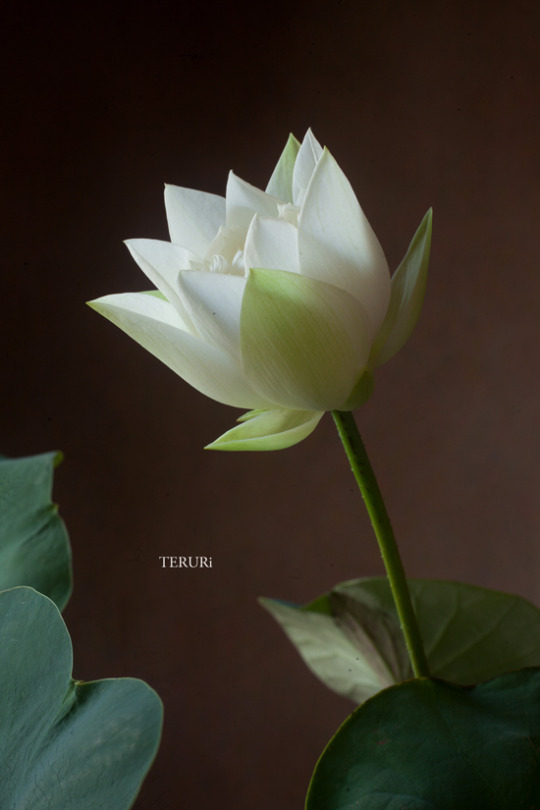
Title:Lotus Flower / Light Of Hope
Buddha says: Bloom a single flower Throughout the life full of muddy water (worldly affairs).
No matter what circumstances you live in now, You can still craft a single beautiful flower Like this lotus flower shows us all.
2,500 years have passed since.
Thank you Sakyamuni Buddha, You are our eternal light of hope.
釈尊曰く:泥の中から一輪の花を咲かせなさい。
如何なる環境下にあろうとも 一輪の希望の花を残すことはできる。
そう語られて幾千年。
合掌。
Go to →
#美#花#beauty#光#light#japan#flower#life#デザイン#light of hope#lotus flower#lotus#the white lotus#blooms#buddha#dharm#釈尊#sakyamuni#eternal light#worldly affairs#一輪の花#ハス#蓮#蓮の花#flowers#お盆#御盆#泥沼#蓮の花の喩え
6 notes
·
View notes
Text
Also fathering a child together lmao
no one is a bigger kdj hypeman than bihyung. whenever kdj does cool anime shonen protagonist type shit, bihyung eats that up every single time. bihyung goes "WOOOO!!!! THAT'S HIM, THAT'S MY GUY!!!!!!!! THIS IS WHO KDJ IS!!!!!!" almost every arc 😭😭
#when he goes to sakyamuni and says 'free my man' and buddha is like 'i see you have picked your side'#if i was a little more crazy i would ship it idk#also dying in kdjs arms. hello.
429 notes
·
View notes
Text
IL PRIMORDIALE BUDDHA MAITREYA NELLE PAROLE DI SAKYAMUNI
IL PRIMORDIALE BUDDHA MAITREYA NELLE PAROLE DI SAKYAMUNI
a cura di Vincenzo Di Maio “Ora in quei giorni, fratelli, sorgerà nel mondo un Essere Entusiasmante di nome Maitreya (il Gentile), un Arhat, un Completamente Illuminato, dotato di saggezza e rettitudine, un Felice, un Conoscitore del Mondo, l’Impareggiabile Auriga degli uomini da domare, un insegnante dei Deva (gli Angeli) e dell’Umanità, un Esaltato, un Buddha come me. Lui, con i Suoi poteri…

View On WordPress
0 notes
Video
Chinese, Votive Stela of Sakyamuni Buddha and Attendant Bodhisattvas, 505, limestone, 8/9/23 #StlArtMuseum by Sharon Mollerus
#Saint Louis Art Museum#505#Chinese#Votive Stela of Sakyamuni Buddha and Attendant Bodhisattvas#Missouri#limestone#StlArtMuseum#St. Louis#MO#flickr
0 notes
Text
"Let us not forget that there is a truth that transcends time and space, the ‘Truth of the Universe. " - Bodhi Day, the day of Shakyamuni's awakening

Bodhi Day is held every year on 8 December as the day on which the Buddha attained enlightenment. It refers to the attainment of enlightenment and the perfection of the path of truth.
Traditions vary, but it is said that Gautama Buddha (Sakyamuni) attained enlightenment at the age of 35 and became a Buddha under the Bodhi tree in Bodh Gaya.
His realisation is ‘truth’. That realisation is ‘the truth of the universe’.
#zen#mindfulness#buddha#buddhism#enlightenment#shakyamuni's awakening#art#nature#wisdom#philosophy#bodhi day
201 notes
·
View notes
Text
one thing i really like about buddhism--particularly mahayana buddhism--is that it understands context, so in my mind it's a very "human" religion. mahayana doesn't tell you to live up to impossible standards but rather, to actually attain what was once thought impossible through whatever means you have. by any means necessary is very applicable to mahayana buddhism.
in the lotus sutra, the buddha states something along the lines of "if a person needs an arhat to be saved, i will appear in the form of an arhat" and proceeds to list down several other forms they might take to save someone, right down to "if they need a common person to be saved, then i will appear in the form of a common person." now, buddhism has been soteriological from the start (it's all about emancipation from the wheel of rebirth after all) but that sutra passage only really served to highlight the major message of the entire sutra: the use of skillful means.
so to me this means buddhism accepts contexts. it doesn't require you to do 180,000 prostrations, it doesn't require you to be a perfect peerless meditative god, it doesn't require you anything that you cannot do at all. it doesn't matter: you will become a buddha all the same. that last bit makes it even better: since in buddhism emancipation means becoming a buddha, when sakyamuni "saves" you he only really supercharges your enlightenment so you can get to it easier, or if another buddha saves you (like amitabha) he whisks you off to his pure land sukhavati so that you can focus a thousand kalpas on just enlightenment without having to be hungry, thirsty, or oppressed.
the majority buddhism in my country is mahayana--it used to be some form of esoteric buddhism during the classical period but that has long since vanished away. though the fact that there has been avalokitesvara images found somewhere in batangas makes it a very spiritual thought to become a buddhist in a country that has partial buddhist roots.
it's mahayana because the buddhism that was brought back here during/after colonization was chinese buddhism. which is dominated by amitabha/pure land buddhism. now one of the most important deities/bodhisattvas in chinese buddhism is guanyin 觀音 (bodhisattva of compassion, who is a strange sinicized version of avalokitesvara). you'll still find her statues in the philippines, especially in parts most concentrated with chinese immmigrants. in one corner of binondo you will see a street shrine with guanyin, mother mary, and jesus christ beside each other, and with passersby offering incense to all three of them.
so since guanyin (who, by the way, is sometimes syncretized to essentially be "chinese mama mary" because religion in religious countries is very bumfuck evades taxonomy) is the most popular bodhisattva in the PH, when tibetan lamas arrived here to teach vajrayana, they adapted a lot of chenrezig rituals even though chenrezig isn't really overtly huge in tibetan buddhism. so now when you go to vajrayana pujas in manila, they almost always have some semblance of chenrezig invocation, and its common to have chenrezig pujas.
another upaya-kaushalya thing i noticed is that buddhism doesn't really do like mass every sunday. but since filipinos have been doing sunday mass for around 300 years now they adapted and now we have sunday pujas because the common filipino expects some sort of religious commitment on sunday
i think buddhism could be a huge boon to socialist movements. cutting through the ego, emphasis on emptiness (that is, nothing has inherent nature, which is essentially mystical materialism), and an emphasis on a sort of helping each other to gain merit would really benefit everyone. especially since unlike christianity they don't force other local religions or local people to change for them, but rather, they retrofit themselves into the local space, adopting the principle of skillful means to help everyone realize their buddhahood.
137 notes
·
View notes
Text

It is said that during his time, one-third of the people respected Sakyamuni Buddha, one-third disliked him, and one-third were indifferent.
If even the Buddha experienced this, it’s only natural that people like us will have those who dislike us too.
Getting caught up in immediate praise or criticism can make us lose sight of the bigger picture. Sometimes, we must remain calm and composed in the face of criticism and move forward.
56 notes
·
View notes
Text

MICAO(Mika Hirasa)
8 April Flower Festival Day
White elephant When the heart is at a loss It gently pushes you on your back Telling me it's going to be okay. Even if it's just a dream I wish I could see you
*Hana Matsuri is a Buddhist event to celebrate the birthday of Sakyamuni Buddha. Its official name is Kambutsu-e (Buddha's Birthday) and it is held on 8 April.
4月8日 花祭り の日
白い象 こころ細い時 そっと背中を押してくれる 大丈夫だよと 夢でもいいから 逢えたらいいのに
31 notes
·
View notes
Text
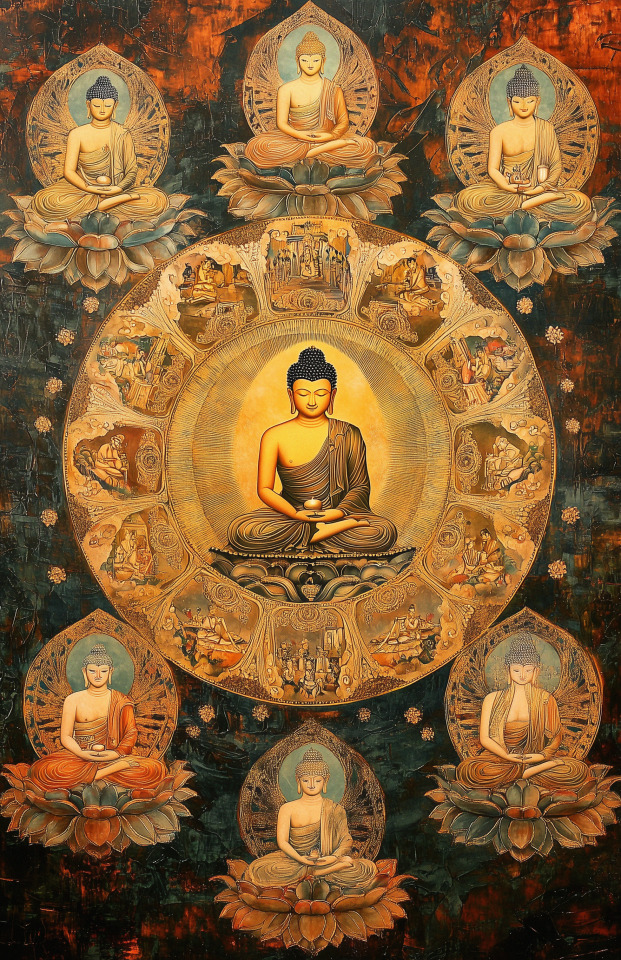
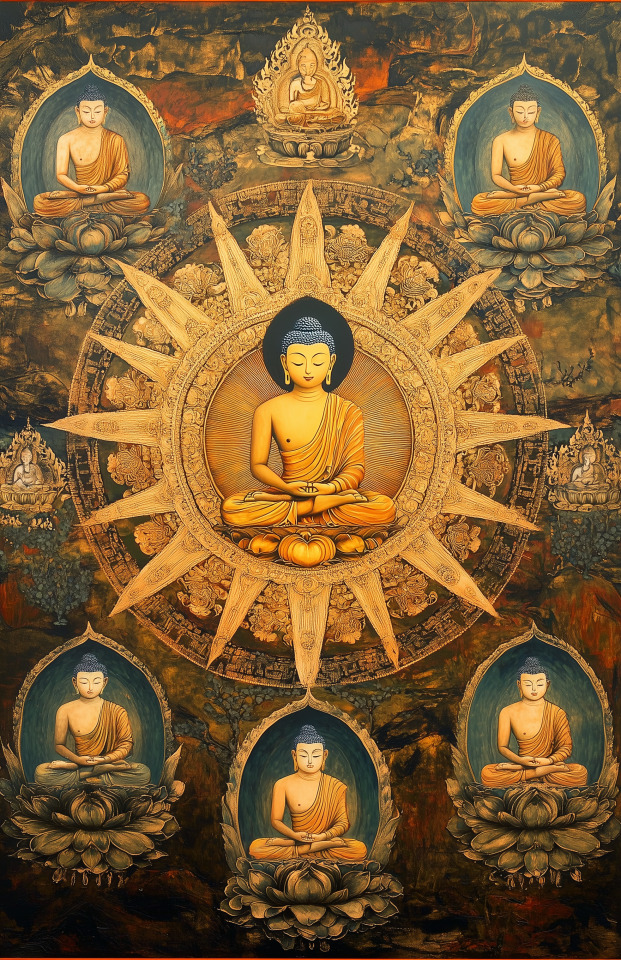
Vairocana | The Five Wisdom Buddhas Talon Abraxas
Not all Buddhas were considered flesh and blood or walked the earth. The Five Wisdom Buddhas are the Wisdom states as persons. The body of Vairocana is the body of the True Dharma.
The Five Wisdom Buddhas arose during the Mahayana development in India and were taken up by Tantric Buddhism. In Japan they appear in Shingon. These Buddhas differ from the Buddhas who appear in the lineage or who are said to have walked the earth at a certain time in a certain place as they represent principles of Mahayana teaching. They are sometimes called ‘Meditation Buddhas’ to distinguish them and because they may only be encountered in the states of meditation that form their bodies.
Vairocana is called the ‘Sun Buddha’ and is the ‘First’ (Skt. Adi) or ‘Primoridial’ Buddha and sits in the central place of the Five Wisdom Buddhas mandala surrounded by the four other Wisdom Buddhas who sit at the cardinal points. His name in Japanese is Dainichi Nyorai – The Buddha of Universal Illumination. His names and attributes are all connected with light and illumination, rays of life-giving power that initiate, nourish and sustain as the sun does all life on earth.
In Mahayana teaching his body is the Body of the Dharma (Skt. Dharmakaya), and is synonymous with such terms in Zen as ‘True Nature’, ‘True Face’ and ‘Buddha-nature’. His nature is emptiness (Skt. Sunyata), the ‘unborn’ of which the Buddha spoke in the Pali Canon, without which that which is born and created could not come into being.
Vairocana first appeared in the Brahmajala Sutra, a 5th Century manuscript written in Sanskrit and translated into Chinese by Kumarajiva. The title translates into English as Brahma’s Net Sutra. This relates to the analogy used by the Buddha who described a net that spreads throughout the universe in the three dimensions of space: length, breadth and depth. Where three strands meet there is a jewel to hold them in place like a dewy spider’s web. Each jewel reflects both itself and all the other jewels in the net simultaneously. The feel of this image is used to point towards the reality of emptiness, the true nature of the Dharmakaya – which is the body of Vairocana.
“Now, I, Vairocana Buddha, am sitting atop a lotus pedestal; on a thousand flowers surrounding me are a thousand Sakyamuni Buddhas. Each flower supports a hundred million worlds; in each world a Sakyamuni Buddha appears. All are seated beneath a Bodhi-tree, all simultaneously attain Buddhahood. All these innumerable Buddhas have Vairocana as their original body. “
-The Brahma’s Net Sutra
As the primordial principle Vairocana speaks outside the phenomenal world where all time is simultaneous. Although in the phenomenal world he has this or that name and is portrayed using this or that hand position (mudra), wearing certain garments and headdress, in truth he is beyond conceptual imagination and yet is ever present in each form, as Master Hakuin wrote: ‘‘like salt in seawater or glue in paint.”
In Shingon Buddhism he is represented by the Sanskrit letter ‘A’ which expresses life & death; emergence & return.
The mantra associated with Vairocana is:
Om a-vi-ra-hûm-kham vajradhâtu vam (Skt.) Om All Pervading One; Imperishable One
77 notes
·
View notes
Text
[Traditional Chinese Festival] Customs of 臘八節(Laba Festival) in China.Eng Sub
Today(January 18, 2024) is the traditional Chinese festival,臘八節 Laba Festival.Let’s learn about some interesting traditions and customs about this festival.
【About 臘八節(Laba Festival)】
Laba Festival (Chinese:臘八節) is a traditional Chinese holiday celebrated on the eighth day of the month of La (or Layue 臘月), the twelfth month of the Chinese calendar. It is the beginning of the Chinese New Year period. It is customary on this day to eat Laba congee.
Laba Festival was not on a fixed day until the Southern and Northern dynasties, when it was influenced by Buddhism and was fixed on the eighth day of twelfth month, which was also the enlightenment day of the Buddha. Therefore, many customs of the Laba Festival are related to Buddhism.
The Laba Festival's name represents its date on the Chinese calendar. La is the name of the twelfth and final month, and ba means "eight/八". In ancient China, the "eight/八" referred to making sacrifices to eight gods at the end of the year.
In its original form, the festival was celebrated by making sacrifices to gods and ancestors to wish for good fortune, health, safety, and a good harvest in the new year. The word la originally referred to these sacrifices.
After Buddhism spread to China during the first century CE, the festival was used as commemoration of Gautama Buddha's enlightenment.It was given a fixed date (the eighth day of the twelfth month) during the Northern and Southern dynasties.
【Customs of 臘八節/Laba Festival?】
Laba congee/臘八粥

Traditionally, the consumption of Laba congee is an important element of the festival. There are multiple legendary accounts of the dish's origins. One story says that it originated in the Song dynasty with Buddhist monasteries giving congee to people in honor of the story that Sakyamuni (Gautama Buddha) reached enlightenment on the eighth day of the twelfth month after eating congee.
Laba congee or Laba porridge (臘八粥; Làbāzhōu) is very popular in many places in China. Different kinds of rice, beans, nuts and dried fruits are the main ingredients. People believe that it's good for health in the winter.
It is also known as "eight-treasure congee" (八宝粥; Bā bǎo zhōu)and is usually made with eight or more ingredients, representing good luck. Eight is a lucky number in China, and the ba in Laba also means eight.
There are many variations of Laba congee in different regions of China. Ingredients can include mixed grains, such as rice, millet, and barley; beans and nuts such as mung beans, azuki beans, lotus seeds, peanuts, walnuts, and chestnuts; dried fruit such as red dates, longan, raisins, and goji berries; and other ingredients such as vegetables and meat.
2.Laba garlic/臘八蒜
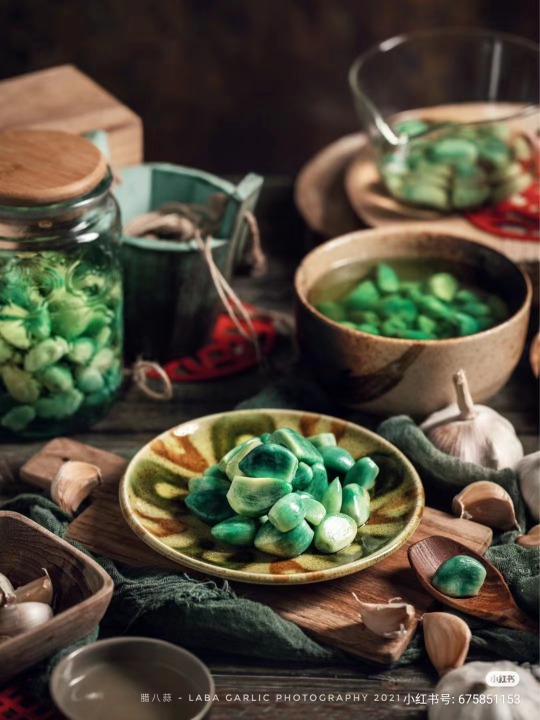
Another Laba food is Laba garlic, which is particularly popular in northern China.Garlic in Chinese (蒜; suàn) has the same pronunciation as calculate (算; suàn), and it is said that on the Laba Festival businesses should balance their books and calculate their revenues and expenditures for the year.Laba garlic is made by soaking garlic in vinegar. Laba garlic is soaked in vinegar from the Laba Festival until Chinese New Year. The garlic and vinegar are then used alongside Chinese dumplings (jiaozi) around Chinese New Year.
————————
🧚🏻Model/Makeup:@曾嚼子&@兔狲猫眠眠
📸 Photo:@逸群闲余
🔗 Xiaohongshu:http://xhslink.com/zlF8Hz
————————
#chinese hanfu#hanfu#Traditional Chinese Festival#臘八節 Laba Festival#chinese culture#chinese customs#chinese history#hanfu accessories#chinese food#china#chinese new year#song dynasty
204 notes
·
View notes
Text
Trivia collection: Nezha in the Tang-Song period
Quick primer: Nezha originates from an Indian deity that gets incorporated into the Buddhist pantheon and imported into China via the spread of Buddhism, then becomes progressively more sinicized + Daoist-ized as a popular folk deity.
Neither his iconography nor backstories stay the same throughout this long process of localization and syncretism, and the vernacular novels that define his modern popular image come relatively late in Nezha's evolution.
This post focuses on Nezha in the Tang-Song period——when he first appeared in translated ritual texts + when the "returning his flesh and blood" thing showed up in written sources.
...
-Before we get to the defining early ritual texts, we must start with the brief mentions of Nezha/Nalakuvara in translated Buddhist scriptures.
-The earliest mention of Nalakuvara as the son of Pishamen, a.k.a. Vaisravana, appeared in the Northern-Southern dynasty translation of Buddhacharita (佛所行赞). Here, he is not refered to using transliterations that have "Na/Nezha" as its first two characters, but as Naluo Jiupo.
-In Bhaiṣajya-vastu, one section of Mūlasarvāstivāda Vinayapiṭaka (根本说一切有部毗奈耶药事), Nezha is brought up in a conversation between Sakyamuni and Ananda. Sakyamuni basically pointed at a mountain and said "100 years after my death, two brothers——Nezha and Pozha——will come along and build a temple here".
-Other scriptures described him as a Yaksha general (in 不空羂索神变真言经), a Devaraja (in 大佛顶陀罗尼), or a "ghost/demon king" (in 吽迦陀野仪轨).
I suppose you can find reasoning for all these readings in the Indo-Buddhist deity he's based on:
1)Nalakuvara the original is the son of Kubera. Vaisravana is either Kubera's epithet or his father.
2) In the Atharva Veda and Satapatha Brahmana, Kubera/Vaisravana rules over either evil spirits or Rakshas.
3) Yaksha/Raksha being among his subjects kinda carried over to the Mahabharata and Ramayana too, in which he's a wealth god who ruled over the city of Lanka, before his half-brother, Ravana, comes along and forced him to move out.
(Nalakuvara also had a wife in Ramayana. Ravana assaulted her, and he put a curse onto Ravana in response.)
4) Buddhism incorporated Kubera into their pantheon as a guardian deity under the name Vaisravana: here, he is the Devaraja of the North and lord of the Yakshas.
5) Because the Indian sources don't have a consensus on whether Nalakuvara's father is a Yaksha/Raksha or a god either, the translated scriptures also can't agree on the specific details of Nezha other than him being a guardian deity.
-It is in Tang Buddhist texts about Pishamen worship that Nezha's status as Pishamen's third son becomes more firmly established.
-However, there are actually 2 different variants of his relation to Pishamen: one said he was Pishamen's grandson, while the other said he was Pishamen's third son.
-The first variant is from Amoghavajra's translation of a ritual text, 北方毗沙门天王随军护法仪轨. In this text, he wields a halberd, "sees all four directions with his fierce eye" (尔时哪吒太子,手捧戟,以恶眼见四方), and will bonk monks and nuns over the head with his vajra club for harboring wicked and murderous thoughts.
-In this text, he is also described as a protector of kings and officials, a subduer of the wicked, and has a mantra one can recite.
-The second variant is found in two other Pishamen-related texts translated by Amoghavajra, 北方毗沙门天王随军护法真言 and 毗沙门仪轨.
-Apart from being Pishamen's third son, both texts also give him the role of pagoda-carrier. In the latter text, it is mentioned that the 21th day of every month is when he hands the pagoda back to his father.
-Another Tang source, 开天传信记, features a story where Nezha protects Xuan Lv, disciple of Śubhakarasiṃha, from a fall, introduces himself as Pishamen's son, and presents a Buddha tooth relic to the Buddhist master.
-He's described as a "youth" here, but honestly, 少年 could refer to anything between a young teen and a young adult. This story has an earlier predecessor in Ennin's travel diary, where he also mentioned Nezha giving a tooth relic to a monk.
-Finally for the Tang dynasty, there is a specific genre of Dunhuang paintings called "Heavenly King Pishamen arrives at Nezha's banquet". Usually, the painting is located on the west wall of the painting cave's antechamber.
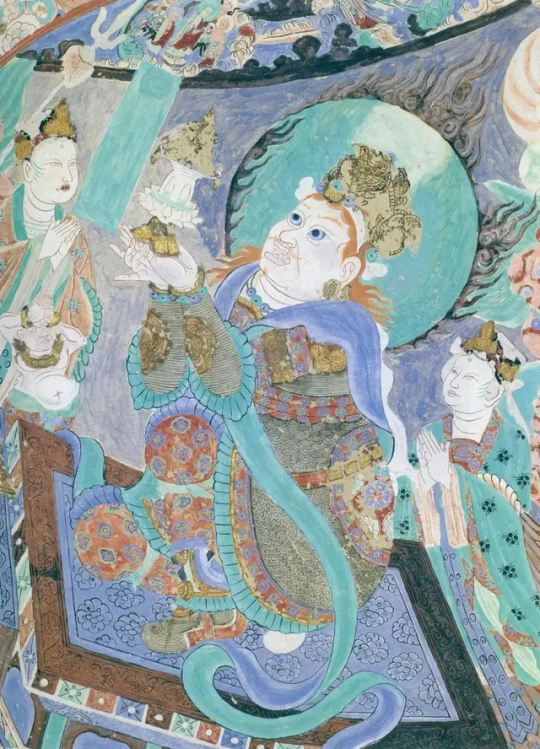
[Mogao Cave 146, main chamber ceiling, northwestern corner. Nezha is likely the small figure on the left, clasping his palms together over his head.]

One Dunhuang text, the P.3564 Mogao Cave Merit Records from 933 CE, gives some context on the aforementioned genre: Pishamen goes to Nezha's banquet, but he either arrives late or not a lot of people show up, and Nezha gets so angry that he's ready to stab Pishamen with a sword, until Pishamen reveals that Amitabha is inside his palm and he cheers up again.
-Based on other inscriptions in Cave 72 where the "Nezha Banquet" paintings are titled as "Amitabha Enters the Pagoda and Arrives at Nezha's Banquet" and "Heavenly Lord Pishamen Invites Amitabha into the Pagoda for Nezha's Banquet", we can make some guesses about the above story.
-Perhaps Pishamen promises Nezha that guests/Amitabha will come to his banquet, no one shows up, thus Nezha gets murderously mad at him until Pishamen reveals Amitabha sitting inside his pagoda like a surprise present?
(Sidenote: later, Pishamen gets syncretized with the historical Tang general, Li Jing, and becomes a separate character known as "Devaraja Li". It wasn't a thing in the Tang-Song sources yet, though.)
-Nezha returning his flesh and bone to his parents is a thing that first shows up in Buddhist compendiums of the Song dynasty (景德传灯录,五灯会元) as a Chan riddle. Being a riddle, it just states that he returns his bones to his father, his flesh to his mother, then sits atop a lotus and preached the Buddhist laws to his parents.
-The "return of flesh & bone" may have been a derivative of Nezha's quote in the aforementioned Tooth Relic story, where he's like "I'll even give up my head and eyes, why won't I offer up [the relic]?"
-The way this riddle has been used, though, is very much centered around identity, seeing through the emptiness of the Five Skandas, and the delusion of the false self.
-There's also this Southern Song quote from 如净和尚语录 that described an opera performance scene where Nezha appeared on stage, likely performing the above narrative of "returning his flesh and bones" because he's described as taking off his clothes.
"…十二峰前上戏棚,那咤赤脱点天强。"
-Su Zhe, brother of the famous poet Su Shi, has an entire poem dedicated to Nezha. Here's a translation of the relevant lines, from Meir Shahar's Oedipal God:
The Northern Heavenly King had a son who was mad: He only venerated the Buddha—not his dad. The Buddha, knowing he was crazy and hard to be told, Ordered the father a magic stupa in his left hand to hold. Approaching the Buddha, the child bowed his head, Not unlike revering his dad.
-Aside from that, he's also known in Song sayings and poems for his wrathful demeanor——to the point of often having the adjective "Wrathful" attached to his name (忿怒哪吒).
-Fun fact, the discrepancy between Nezha having 6 arms or 8 arms appears in this period too, though 8 arms are the more commonly accepted version in textual sources.
-Lastly, a story from the Southern Song compendium Yijian Zhi mentions Daoist Master Cheng from the Mt. Mao tradition using Nezha's Fireball Spell to defeat a stone demon. This may be the first appearance of a Daoist-ized Nezha.
TL;DR: Nezha in the Tang-Song period was very much a Buddhist guardian deity who miiiight also be a Yaksha general, most well-known for his wrathful demeanor and multi-headed, multi-armed form.
The earliest mentions of the "Returning of flesh and bones" also don't have its later association with filial piety/father-son conflict, and is mostly a Chan Buddhist riddle.
Bibliography:
付方彦,《哪吒形象流变研究》
郭俊叶,《托塔天王与哪吒——兼谈敦煌毗沙门天王赴哪吒会图》
李小荣, 《那吒故事起源补考》
刘文刚,《哪吒神形象演化考论》
罗俊,《符号学视角下中国古代哪吒形象的演变》
任婧,《从无名氏到大英雄:论哪吒形象的演变与东传》
Shahar, Meir. Oedipal God: The Chinese Nezha and His Indian Origins. University of Hawai'i Press, 2015.
王彦明,《哪吒话头的禅林传播与明清小说的多元互动》
#chinese mythology#chinese folklore#nezha#nalakuvara#mahabharata#ramayana#hindu mythology#buddhism#at the risk of provoking discourse#anyone who cite “Chinese Mythology” for the Eternally 12 Myth#yet have no idea who Nalakuvara is#or Nezha's appearances in texts that precede JTTW and FSYY#deserve a good smack on their noggin'
44 notes
·
View notes
Note
Huh I wonder if there was Kaizenix arc in the 1865th regression
Okay, well I do have a joke-y theory since we can't really know for sure.
So we don't actually know the activation parameters for it, since the notable thing about Kaizenix arc is that it doesn't happen in Ways of Survival at all. (There is some 'body possesion' scenario Kim Dokja vaguely remembers, but it is not kaizenix.) That's rounds 3-1863 of not even a hint of it!
BUT then we are told it does happen in the 1863rd and 1864th rounds both, not so coincidentally the only rounds where Han Sooyoung is around. So that could be the trigger.
the only logical conclusion here is that kaizenix exists exclusively when yoohan need to get weird with each other. and in that case, it definitely happens in the 'yoohan powercouple moment' round of 1865.
this also means that sakyamuni is a huge yoohan shipper who facilitates their hatesex in 3 different turns. W buddha
#i feel like kim dokja when i talk about the individual differences in each regressions. so cringe#asks#yoohan#orv#omniscient reader's viewpoint#orv spoilers#kaizenix arc#my posts
69 notes
·
View notes
Text

"Sakyamuni (Buddha) Announces Another Prophet", Folio from a Majma al-Tavarikh (Compendium of Histories). Created by Hafiz-i Abru, Iranian born artist. Attributed to Afghanistan. 1425 CE.
The Metropolitan Museum of Art.
#Hafiz-i Abru#afghanistan#iranian art#Iran#afghan#literature#early modern history#early modern period#art#culture#manuscript#the metropolitan#buddha#history
9 notes
·
View notes
Text

The mind that is single, is the true cause, of birth, in the pure, fulfilled land.
May all accept Amida's gift of shinjin. And obtain birth in his land of peace and bliss.
Wherever the Name
Japanese: Namo Amida Butsu
English: Namo Amitabha
Chinese: Namo Amituofo
Korean: Namu Amita Bul
Vietnamese: Nam mô A Di Đà Phật
Tibetan: Om Ami Dewa Hri
is present, the Buddha is one with it and all the virtues of the Tathagata are embodied within it.
This is the reason why the Name has the power to save sentient beings.
The logic of the nature of Amida Buddha and the perfection of his Vows leads to the conclusion that one is saved whether or not he consciously knows about it, or whether he is good or evil.
Namo Amida Butsu Namo Amida Butsu Namo Amida Butsu
Namo Amitabha Buddha, Namo Amitabha Buddha. Namo Amitabha Buddha.
Namo Amitoufo, Namo Amitoufo, Namo Amitoufo
Guiding Principles
Faith in, and acceptance of, Amitabha's deliverance
Single-minded recitation of Amitabha's name
Aspiration to rebirth in Amitabha's Pure Land
Comprehensive deliverance of all sentient beings.
Shinjin
Shinjin is a central concept in Shin Buddhism which indicates a state of mind which totally entrusts oneself to Amitabha Buddha's other-power, having utterly abandoned any form of self-effort or calculation. The term is variously translated as "entrusting mind", "true entrusting", "true faith", "trusting heart-mind".
Nembutsu
In Pure Land Buddhism, the practice of nembutsu is believed to lead to rebirth in the Pure Land of Perfect Bliss. Nembutsu can mean "to recite aloud". This practice involves calling the Buddha's name, either orally or mentally. The Japanese phrase for the oral invocation of the Buddha Amitābha is Namu Amida Butsu, which means "Hail to Amitābha Buddha. Nembutsu as meditation is the Japanese term which means to think on or contemplate the Buddha. It has a long history in Buddhism and has been considered the central core of practice to gain enlightenment Sakyamuni Buddha used this practice in order to gain enlightenment.
Bombu
Bombu is a Buddhist term that means "ordinary beings" or "ordinary person". It refers to the human condition of being ignorant or unenlightened, as opposed to being awakened or enlightened like Buddhas and Bodhisattvas. In Shin Buddhist philosophy, the recognition of one's bombu nature is a key part of the religious awakening. This recognition occurs when one awakens to the unconditional love and compassion of Amida Buddha, who saves all beings without discrimination. The bombu paradigm is a feature of Pure Land Buddhism that teaches that total reform is impossible in the world of conditions. It also teaches that the effort to achieve perfection can be counterproductive, leading to spiritual pride.
May all practitioners of deep mind single-heartedly accept the Buddha's words and hold fast to the Nembutsu practice, even at the risk of their own lives.
#buddha#buddhist#buddhism#dharma#sangha#mahayana#zen#milarepa#tibetan buddhism#thich nhat hanh#Nianfo#Namo Amituofo#Namo Amida Butsu#amitabha#avalokiteshvara#amitabachan#amitaba buddha#pure land#sukhavati#dewachen#enlightenment spiritualawakening reincarnation tibetan siddhi yoga naga buddha
10 notes
·
View notes